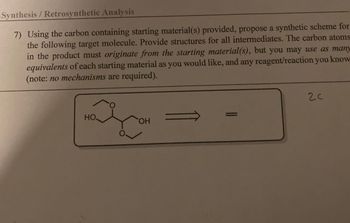ynthesis / Retrosy 7) Using the carbon containing starting material(s) provided, propose a synthetic scheme for the following target molecule. Provide structures for all intermediates. The carbon atoms in the product must originate from the starting material(s), but you may use as many equivalents of each starting material as you would like, and any reagent/reaction you know (note: no mechanisms are required). НО. OH 20
ynthesis / Retrosy 7) Using the carbon containing starting material(s) provided, propose a synthetic scheme for the following target molecule. Provide structures for all intermediates. The carbon atoms in the product must originate from the starting material(s), but you may use as many equivalents of each starting material as you would like, and any reagent/reaction you know (note: no mechanisms are required). НО. OH 20
Chemistry
10th Edition
ISBN:9781305957404
Author:Steven S. Zumdahl, Susan A. Zumdahl, Donald J. DeCoste
Publisher:Steven S. Zumdahl, Susan A. Zumdahl, Donald J. DeCoste
Chapter1: Chemical Foundations
Section: Chapter Questions
Problem 1RQ: Define and explain the differences between the following terms. a. law and theory b. theory and...
Related questions
Question
Question in Image. Synthesis.

Transcribed Image Text:**Synthesis / Retrosynthetic Analysis**
**Question 7:**
Using the provided carbon-containing starting material(s), propose a synthetic scheme for the target molecule. Provide structures for all intermediates. The carbon atoms in the product must originate from the starting material(s), but you may use as many equivalents of each starting material as you would like, and employ any reagent/reaction you know. *(Note: no mechanisms are required).*
**Diagram Explanation:**
The diagram shows a chemical structure with the following features:
- A central carbon chain with two hydroxyl (OH) groups attached.
- An ester linkage (C-O) connecting two parts of the molecule.
**Task:**
Develop a synthetic pathway starting with the given structure to reach the desired target molecule, ensuring all intermediates are clearly drawn. Reagents and reactions can be chosen freely, but all carbon atoms in the final product must be derived from the initial starting materials provided.
Expert Solution
This question has been solved!
Explore an expertly crafted, step-by-step solution for a thorough understanding of key concepts.
This is a popular solution!
Trending now
This is a popular solution!
Step by step
Solved in 2 steps with 1 images

Follow-up Questions
Read through expert solutions to related follow-up questions below.
Follow-up Question
Synthesis problem. Is there a solution without using the Birch reduction?

Transcribed Image Text:Synthesis / Retrosynthetic Analysis
7) Using the carbon containing starting material(s) provided, propose a synthetic scheme for
the following target molecule. Provide structures for all intermediates. The carbon atoms
in the product must originate from the starting material(s), but you may use as many
equivalents of each starting material as you would like, and any reagent/reaction you know
(note: no mechanisms are required).
НО.
O
OH
=
2C
Solution
Knowledge Booster
Learn more about
Need a deep-dive on the concept behind this application? Look no further. Learn more about this topic, chemistry and related others by exploring similar questions and additional content below.Recommended textbooks for you

Chemistry
Chemistry
ISBN:
9781305957404
Author:
Steven S. Zumdahl, Susan A. Zumdahl, Donald J. DeCoste
Publisher:
Cengage Learning

Chemistry
Chemistry
ISBN:
9781259911156
Author:
Raymond Chang Dr., Jason Overby Professor
Publisher:
McGraw-Hill Education

Principles of Instrumental Analysis
Chemistry
ISBN:
9781305577213
Author:
Douglas A. Skoog, F. James Holler, Stanley R. Crouch
Publisher:
Cengage Learning

Chemistry
Chemistry
ISBN:
9781305957404
Author:
Steven S. Zumdahl, Susan A. Zumdahl, Donald J. DeCoste
Publisher:
Cengage Learning

Chemistry
Chemistry
ISBN:
9781259911156
Author:
Raymond Chang Dr., Jason Overby Professor
Publisher:
McGraw-Hill Education

Principles of Instrumental Analysis
Chemistry
ISBN:
9781305577213
Author:
Douglas A. Skoog, F. James Holler, Stanley R. Crouch
Publisher:
Cengage Learning

Organic Chemistry
Chemistry
ISBN:
9780078021558
Author:
Janice Gorzynski Smith Dr.
Publisher:
McGraw-Hill Education

Chemistry: Principles and Reactions
Chemistry
ISBN:
9781305079373
Author:
William L. Masterton, Cecile N. Hurley
Publisher:
Cengage Learning

Elementary Principles of Chemical Processes, Bind…
Chemistry
ISBN:
9781118431221
Author:
Richard M. Felder, Ronald W. Rousseau, Lisa G. Bullard
Publisher:
WILEY